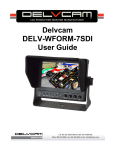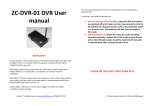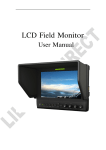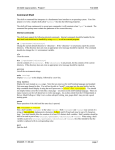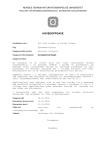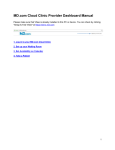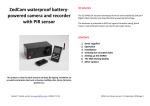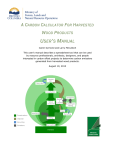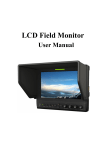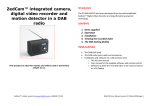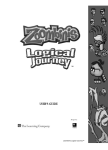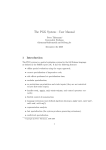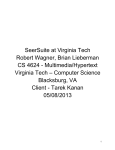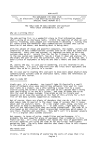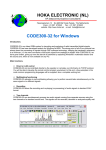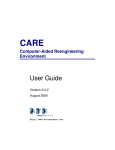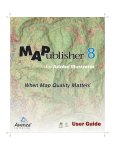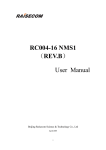Download Final Report.docx - VTechWorks
Transcript
CS Seminar CS 4624 Virginia Tech - Blacksburg, VA May 8, 2013 Kyle Gibb, Derek Ong, Sivani Parbadia, Glen Tona Clients: Professor Manuel A Perez-Quinonez - [email protected], Ryan Chase - [email protected], Nathan Hall [email protected] 1 Table of Contents Executive Summary ................................................................................................................................. 3 User’s Manual ......................................................................................................................................... 3 Developer’s Manual ................................................................................................................................ 5 Suggestions for Future Improvement................................................................................................. 11 Lessons Learned .................................................................................................................................... 12 Timeline/Schedule ............................................................................................................................. 12 Problems/Solutions ........................................................................................................................... 12 Skills Acquired ................................................................................................................................... 13 Acknowledgements ............................................................................................................................... 13 References ............................................................................................................................................ 14 2 Executive Summary Computer Science seminars are a very educational and interesting aspect that the CS department offers to the students attending the university as well as staff, faculty, and visitors. There are numerous occasions in which many students are not able to attend the seminars. Taking this into consideration our group was responsible for the digital video recording and editing of the CS Seminar talks. This allows for students to re-watch a seminar if they can’t remember all the information. Each seminar is held on Friday at 11:15am in Torg 2150. We recorded each CS Seminar, edited it, and posted it to the VTechWorks website that is located at this link: http://vtechworks.lib.vt.edu/handle/10919/19036. This project has been an ongoing project as seminars and talks are held every semester. The main purpose, along with what was described above, is to attract more people to Computer Science and support the Computer Science department based on research discussed in the seminars. Having these seminars uploaded onto a website that is easily accessible will generate interest in the computer science field as well as give people already in the field something potentially new and interesting to think about. In order to accomplish this task our group had to have some kind of prior knowledge of videography and video editing. User’s Manual In this section we will explain the steps to watch the videos online. First navigate to the URL http://vtechworks.lib.vt.edu/handle/10919/19036. This will bring you to the main page in which the videos are hosted. This page however only has links to the five most recent submissions. In order to view all the videos click the “By Issue Date” button on the left side of the page under the “This Collection” title. 3 Then, if you would like to see the most recent videos change the “Order” drop down menu to descending and click Update. 4 Last, just click the link to the seminar you would like to watch and the video will be embedded at the top of the page. Developer’s Manual Once you shoot the raw video, you will need to edit it using a video editing program. We used iMovie on a Mac laptop. You may wish to use a different program. The instructions below are for iMovie, for other software look online for guides. First, you will need to import the video from your camera into iMovie. This can be done from File > Import from Camera. Next, you will want to create a new project. This can be done by clicking on the “+” symbol at the bottom right of the project library window, which is in the top left corner. 5 You will now see the project manager in the top left. You may want to add a title segment to the beginning of the video, which can be done by clicking the “T” along the right side of the window and dragging a title into the project. Once you drop a title into the manager, a popup will let you choose the color style. In this example we will use the “Gradient” style. 6 Next you’ll want to select the clip or clips from your video and drag it into the project. The yellow box shows the beginning and end of the clip being selected. Once you’ve added in all the clips you want, you may want to add ending credits or something similar. Again, this can be found in the title selector. The “Scrolling Credits” title is a typical one to use for end credits. Drag it onto the back of your project to add it; you can also change the length by double clicking on it. 7 The video should now be finished and needs to be exported. Go to Share>Export Movie from the menu. This option exports the video as an MPEG-4. For different export formats you can use the “Export using QuickTime” option from the Share menu. You can also select various sizes to 8 export the video in; we used Medium as our client told us that he didn’t want the video to be high resolution. Smaller file size also means it is easier for users to stream it. You should make sure to keep a backup of the iMovie project so you can export at a higher resolution later if needed. Finally, we want a WebM format video for streaming on VTechWorks. We downloaded a simple program called Miro Video Converter to do this; you simply select the WebM format and drag the video you want to convert into the specified area. 9 All that remains is to upload the videos and any other material you might have such as the lecturer’s slides to the VTechWorks website for users to access. For one of the videos, we had a Camtasia capture which normally allows you to combine a camera recording with a screen recording from a computer. However, the screen recording was not centered correctly and was unusable. We ended up having to manually create images for each slide and add them to the video one by one. This took a huge amount of time so we would not recommend using this strategy for future seminar videos. Instead, recording one video that captures both the presenter and their slides at once seems to be a more efficient approach. The cameras we used were all of the same type from VT’s Knowledge Works. At the time of writing we no longer have access to these cameras, but they can be easily obtained by groups in future semesters by reserving them far in advance of each seminar talk. We only used one camera for each recording as that was the number Knowledge works allowed us to rent. It may be worth looking into using multi-cam setups in future semesters, but this would greatly add to the editing time required to produce the final videos to put on VTechWorks. Here is a table listing details of each seminar we recorded: Date 1 Feb 2013 8 Feb 2013 15 Feb 2013 Presenter David Evans Clayton Lewis Wu Feng Talk Length 49:49 1:08:04 1:08:24 Size of .m4v 611 MB 836 MB 840 MB Size of .webm 138 MB 183 MB 185 MB 10 22 Feb 2013 12 April 2013 19 April 2013 26 April 2013 3 May 2013 Charles Consel Lucy Nowell Lee Osterweil, Lori Clarke Alex Endert, Paul Sathre Dennis Kafura 59:31 54:46 1:06:28 730 MB 502 MB 816 MB 161 MB 293 MB 182 MB 42:26 520 MB 115 MB 58:25 717 MB 148 MB In general, each video took about an hour to one and a half hours of editing to make sure that the audio and video throughout were of sufficient quality, to look up the information required for the titles, to edit any clips together, and to export the videos to the required formats. There were occasional audio issues, especially in the interview sessions, but because it was generally issues caused by the recording equipment, very little or nothing could be done to salvage these parts. Because we only used one camera, there was no need to merge video from any other sources than that camera. Suggestions for Future Improvement One issue that we had when recording the seminars was that it was difficult to reliably get the presenters’ lecture slides so we could upload them to VTechWorks along with the recording. More effort should be placed on making sure these slides are obtained in future semesters. Some suggestions include: reaching out to the presenter ahead of the lecture, using a flash drive to gain a copy directly before or after the lecture, or more strongly following up after the lecture to get the presenter to email a copy. It is best to contact the speaker as early as possible and only get the slides post-lecture as a last resort. Along with getting copies of the slides, another issue we had was not capturing the entire slide projected onto the wall behind the presenter in the video, making it harder for viewers to understand what the presenter was discussing. It is not really necessary to get close-up views of the presenters’ faces for these videos, so another recommendation would be to make sure the shots are wide enough to capture the entire projection. This could also help with the 1 st recommendation in cases when the presenter does not give the recorders his/her slides. Finally, it may be worth taking a close up of the presenter and then later combining that footage with the slides to create a hybrid video showing both. This would require more work on the part of the people recording the presentation (they would have to follow the presenter with the camera) and the video editor (need to link up the slides with the talk), but the resulting benefit may outweigh the additional work. Groups recording these seminars in the future may want to consider these trade-offs and plan accordingly. 11 Lessons Learned Timeline/Schedule In this project we learned how to work in groups outside of a classroom scene as all the information was requested by a client. Our original timeline was parallel to the scheduled seminars we were recording. Our schedule involved first recording the seminars every Friday from 11:15am to 12:15pm. Next, conduct a 15 minute one-on-one interview with the speaker either right after the seminar or later that afternoon during the ‘Meet the Speaker’ session in McBryde. Following the interview, we extracted and edited the video, after which we then uploaded online. We also made website updates throughout the semester. Our plan was to get each video uploaded within three days of the recording. Problems/Solutions Often times, we ran into problems due to lack of communication with the client, with each other, or malfunction of the equipment. In general, we learned to adapt to these issues, and made a team effort in order to ensure good performance. For instance, if the client did not mention camera recording angles then we asked them what angles they would like us to us thus, ensuring that after the video was recorded the client liked the position. The quick changes in schedule also made the team more flexible. Each member had a specific task and we made each other available to help with certain circumstances and last minute changes. This allowed for an efficient and dynamic group. In order to prevent future problems we would try and identify what hadn’t been working thus far and change our methods accordingly. One of the most important lessons we learned is that when you are dealing with clients, we needed to be in constant connection for every seminar, recording, and interview as plans usually changed. Another major lesson we learned is that we need to plan as far in advance as possible since clients can be very busy people. The project started very quickly and we needed to be in complete understanding of the room’s video and audio equipment and obtain our own recording equipment as well as connect our equipment to the room’s equipment. In order to adapt to how soon the first seminar was, we got the camera as quickly as possible to figure out how the equipment worked. 12 Skills Acquired This project was focused on parts of multimedia that most of our members had not worked with before. From the web development perspective, we learned a lot about building internal Virginia Tech pages with correct branding as well as uploading systems and embedding videos into web pages. For the actual video editing, we learned many professional video creations with effects that are a standard in today’s multimedia world. We learned to use tools such as iMovie, Final Cut Pro and camtasia in order to deliver professional grade results. Some other techniques included sound clippings, pacing, color leveling, and transitions. During the recording of the interviews, we learned to utilize high-end cameras with wireless microphone systems. We learned about camera angles, live image sharpening, and zooming effects that made the video more dynamic as recording. Finally, for the one-on-one interviews we also learned posture, distance, and voice emphasis in order to make for a smooth, entertaining, and accurate interview. Acknowledgements We received a lot of help throughout this project and we wanted to mention some of the people that aided us through the semester. Thank you for the chance to work on this project and all the help you have provided. We truly appreciate the guidance we’ve had this semester. Manuel A Perez-Quinonez Client Assoc. Department Head for Graduate Studies, Assoc. Professor Computer Science 2202 Kraft Drive, Office 1125 Virginia Tech Blacksburg, VA 24060 United States E-mail: [email protected] Work: (540) 231-2646 Ryan Michael Chase Client Lead Systems Engineer Computer Science Department 2202 Kraft Dr. Blacksburg, VA 24060 E-mail: [email protected] 13 Work: (540) 231-1396 Nathan Hall Very helpful in guiding us on how to upload videos and how to edit the page. VTechWorks Librarian Client Library (0434) University Libraries Digital Library and Archives Blacksburg, VA 24062 United States E-mail: [email protected] Work: (540) 231-1751 Edward Fox Aided in video development, client contact and assisted in recording during one seminar. Professor Computer Science 2160G Torgersen Hall Virginia Tech Blacksburg, VA 24061 E-mail: [email protected] Work: (540) 231-5113 Jeffrey E Dalton & his staff from TV Broadcasting Services Provided tutorials in video/audio editing and interview setup, lighting and posture. Multimedia Producer Director Senior Video/Broadcast Services 288 Whittemore Hall Blacksburg, VA 24061 E-mail: [email protected] Work: (540) 231-8987 James C Dustin Aided in renting and teaching how to operate recording equipment Operations Coordinator InnovationSpace 1140-E Torgersen Hall Blacksburg, VA 24061-0292 United States E-mail: [email protected] Work: (540) 231-3405 References Dalton, Jeffrey E. "Skip Menu." Video Network Operations. Virginia Tech, n.d. Web. <http://www.vbs.vt.edu/>. 13 Mrch 2013. 14 More Info: Services include interactive video conferencing, multimedia production as well as streaming media. Dustin, James C. "Spotlight On..." Spotlight On... Virginia Tech Learning Services, <http://www.is.vt.edu/>. 2 Feb. 2013. More Info: Provide equipment, tours, consultations and assistance with audio and video troubleshooting. Staff. "Search VTechWorks." Browsing by Issue Date. Virginia Tech Library Services, 20 Feb. 2013. Web. <http://vtechworks.lib.vt.edu/> 08 May 2013. More Info: Contains collections, communities and publications related to Virginia tech that users can browse. 15















